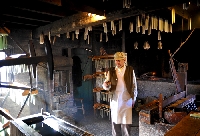Types of candle waxes
By Catalogs Editorial Staff

Research types of candle waxes before you make start making your own candles
Candles are functional ? they provide light when the electricity goes out ? and beautiful. They create ambiance and a great fragrance if they are scented. A candle-lit room is very romantic.
There are various types of candle waxes that can be used when creating your own candles. The wax is what fuels the candle and each type of wax has its own characteristics. The wax that you use also has an impact on the way your candle looks and the effects that it produces.
Not all waxes melt at the same temperature. The melting point is when the wax changes from solid to liquid so you must know the melting point of the wax you use when making candles. The wax has to be poured when it reaches a certain temperature.
Beeswax
One option is beeswax for candlemaking which is naturally scented and sweet and smokeless, burns very slowly and is a natural form of wax. It is sticky so it is best to use it when creating candles that are not molded. The melting point for beeswax is approximately 150 degrees F. Beeswax can be costly.
Paraffin
Lots of candle makers use paraffin wax, which comes in various grades. Paraffin wax is a by-product of crude oil. Paraffin that is specified as having a low melting point melts at 130 degrees or less than that temperature. A low melting point paraffin is good for creating candles in containers because it is soft. On the other hand, this softness makes this grade of paraffin not ideal for constructing carved or molded candles.
~
When making poured candles, it is suggested that you use medium melting point paraffin. It becomes a solid at 130 to 145 degrees F. This version of paraffin is extremely soft so it isn?t good to use when making carved or molded candles.
High melting point paraffin candle wax melts when the temperature reaches 145 to 150 degrees F. This is the wax to use when making molded and carved candles because it is quite hard. It has a much longer burn time than the softer types of paraffin.
Tallow
Centuries ago, tallow was used to create candles. Tallow consists of sheep-, pig and cow fat. It sometimes smells oddly as a result and smokes a lot. Tallow is a natural wax and should be used when you are making candles in containers because it is soft and has a low melting point.
Bayberry Wax
Bayberry wax is made from bayberry bush berries that have been boiled. Bayberry wax melts at approximately 118 degrees F. It is expensive because it takes about 15 pounds of bayberry to create one pound of wax. This wax is green and has a natural berry scent.
Soy Wax
More and more candle makers are turning to soy wax because it doesn?t cost much, is clean-burning and is natural. Soy wax doesn?t shrink much during the process of making the candle and it grasps onto the scent better than paraffin wax does. Soy wax has natural oils in it that complement fragrant oil. Its melting point is between 120 and 180 degrees F. One other perk of using soy wax is that the candle maker does not have to tap it to remove air bubbles because air pockets do not normally form in soy wax.
Palm Wax
Palm wax is made from palm oil. It is comparable to soy wax in that it is created from natural oil. This type of wax is quite firm and almost brittle. It is good for votives and pillars and can be combined with soy wax to make it even harder. Palm wax creates a feathered or crystalline effect.
Gel Wax
Gel wax is another option. It isn?t really a wax. It is made from a combination of mineral oil and resin. Gel wax is transparent and holds color and scent well and burns much like other waxes.
Popular Savings Offers











